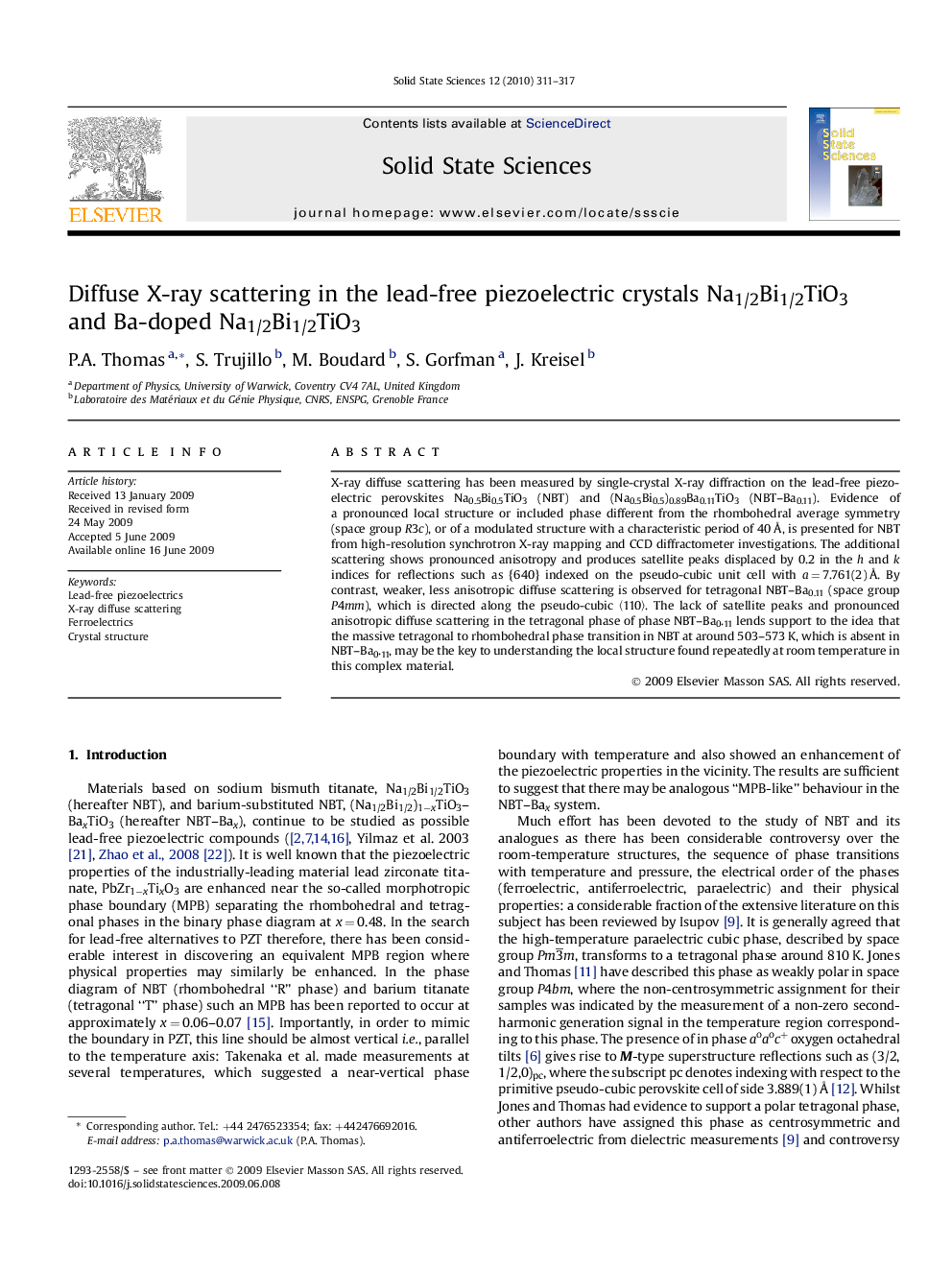| کد مقاله | کد نشریه | سال انتشار | مقاله انگلیسی | نسخه تمام متن |
|---|---|---|---|---|
| 1506491 | 993797 | 2010 | 7 صفحه PDF | دانلود رایگان |

X-ray diffuse scattering has been measured by single-crystal X-ray diffraction on the lead-free piezoelectric perovskites Na0.5Bi0.5TiO3 (NBT) and (Na0.5Bi0.5)0.89Ba0.11TiO3 (NBT–Ba0.11). Evidence of a pronounced local structure or included phase different from the rhombohedral average symmetry (space group R3c), or of a modulated structure with a characteristic period of 40 Å, is presented for NBT from high-resolution synchrotron X-ray mapping and CCD diffractometer investigations. The additional scattering shows pronounced anisotropy and produces satellite peaks displaced by 0.2 in the h and k indices for reflections such as {640} indexed on the pseudo-cubic unit cell with a = 7.761(2) Å. By contrast, weaker, less anisotropic diffuse scattering is observed for tetragonal NBT–Ba0.11 (space group P4mm), which is directed along the pseudo-cubic 〈110〉. The lack of satellite peaks and pronounced anisotropic diffuse scattering in the tetragonal phase of phase NBT–Ba0.11 lends support to the idea that the massive tetragonal to rhombohedral phase transition in NBT at around 503–573 K, which is absent in NBT–Ba0.11, may be the key to understanding the local structure found repeatedly at room temperature in this complex material.
X-ray diffuse scattering has been measured by single-crystal X-ray diffraction on the lead-free piezoelectric perovskites Na0.5Bi0.5TiO3(NBT) and (Na0.5Bi0.5)0.89Ba0.11TiO3 (NBT–Ba0.11). Evidence of a pronounced local structure or included phase different from the rhombohedral average symmetry (assumed here to be described by the conventionally-accepted space group R3c), or of a modulated structure with a characteristic period of 40 Å, is presented for NBT from high-resolution synchrotron X-ray mapping and CCD diffractometer investigations. The additional scattering shows pronounced directionality and produces satellite peaks displaced by 0.2 in the h and k indices for reflections such as −6−40 indexed on the pseudo-cubic unit cell with a = 7.761(2) Å. By contrast, the diffuse scattering in tetragonal NBT–Ba0.11 (space group P4mm) is shown to be less pronounced and anisotropic, with only a weak tendency for enhancement along the pseudo-cubic 〈110〉 directions. The lack of satellite peaks and pronounced localised diffuse scattering in the tetragonal phase of phase NBT–Ba0.11 lends support to the idea that the massive tetragonal to rhombohedral phase transition in NBT at around 503–573 K, which may proceed through an orthorhombic antiferroelectric intermediate phase, is the key to understanding the local structure found repeatedly at room temperature in this complex material.The figure shows a high-resolution reciprocal space section through l = 0 of the (−6−40)dpc reflection from NBT collected at Station 16.3, Daresbury Laboratory, λ = 0.497 Å, collected at 115 K. The false colour scale is logarithmic from deep blue (log10I = 1.8) to deep red (log10I = 3.4), where I is the intensity in arbitrary units. The axis labels H and K measure the equivalent h and k at each point in reciprocal space as continuous variables. The axes are parallel to the [100]pc and [010]pc pseudo-cubic directions, which are in turn parallel with the a and b axes of the rhombohedral unit cell to within <0.1°. The positions of the satellite peaks suggest a characteristic length scale of ∼40 Å.Figure optionsDownload as PowerPoint slide
Journal: Solid State Sciences - Volume 12, Issue 3, March 2010, Pages 311–317